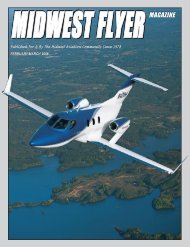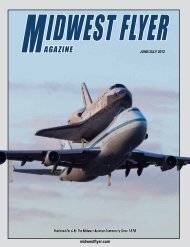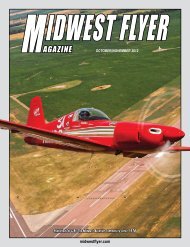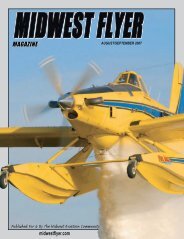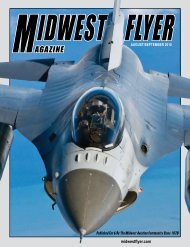Create successful ePaper yourself
Turn your PDF publications into a flip-book with our unique Google optimized e-Paper software.
not let students look at the chart once<br />
inside the final approach fix (FAF). In<br />
fact, I take the chart away from them.<br />
Early on I asked a student what he<br />
was looking to find on the chart, as<br />
we pegged the glide-slope (GS) and<br />
localizer (LOC) needles. He told me he<br />
wanted to see if there was something he<br />
might have missed on the chart. Some<br />
charts are straightforward, and others<br />
have notations that might cause you to<br />
pick a different approach. So, there are<br />
some memory items we must use if we<br />
cannot look at the chart inside the FAF,<br />
and it’s easy to do!<br />
Let’s look at a precision approach<br />
first (an approach with a glide-slope).<br />
We are already established on the<br />
approach, so course is known. Now,<br />
how low can we go, memory item #1;<br />
this is also the missed approach point<br />
(MAP), item #2. The last memory item<br />
(#3) is the missed approach procedure.<br />
Every missed approach I have seen<br />
begins with a climb (see fig 3), and that<br />
can have three (3) options – straight<br />
Figure 3<br />
ahead, left turn or right turn. Both<br />
Jeppesen and the government charts<br />
have pictorial descriptions of the missed<br />
approach that we call “briefing strips.”<br />
Once the missed approach has begun<br />
and all is under control, we can go back<br />
to the chart and read it to find where<br />
we are going to go. If the approach is<br />
a non-precision item, #1 and #2 will<br />
not be the same, so another item to<br />
remember. To help us senior pilots with<br />
failing memories, there is an altitude<br />
bug that one can purchase from Sporty’s<br />
Pilot Shop. This sticks to the altimeter<br />
and is a great aid. Try this technique the<br />
next time you fly and see if it keeps you<br />
focused on the task when “hand flying<br />
the airplane.”<br />
Till the next issue, blue skies and<br />
tailwinds!<br />
EDITOR’S NOTE: Michael J. "Mick"<br />
Kaufman is a Certified Instrument<br />
Flight Instructor (CFII) and the program<br />
manager of flight operations with<br />
“Bonanza/Baron Pilot Training,”<br />
operating out of Lone Rock (LNR)<br />
and Eagle River (EGV), Wisconsin.<br />
Kaufman was named "FAA's Safety<br />
Team Representative of the Year for<br />
Wisconsin" in 2008. Email questions to<br />
captmick@me.com or call<br />
817-988-0174.<br />
q<br />
JUNE/JULY 2013 MIDWEST FLYER MAGAZINE 13



